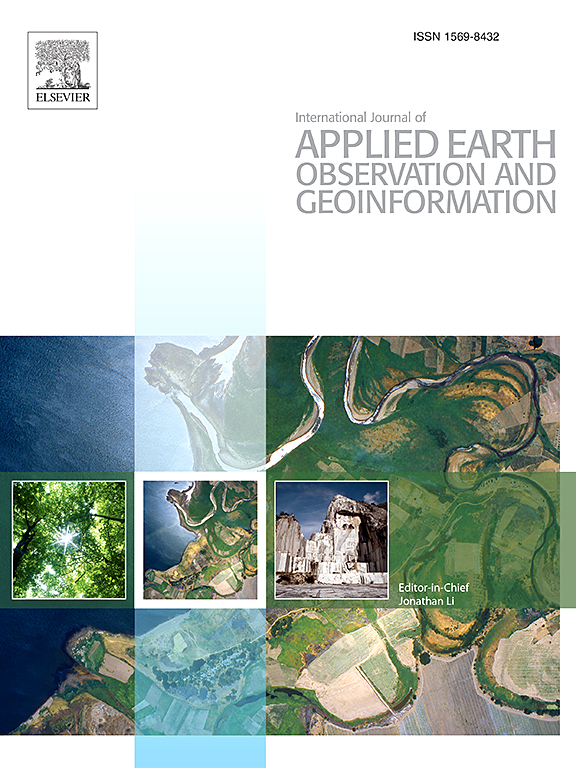Enhancing water scarcity resilience in Egypt through machine learning-driven phenological crop mapping and water use efficiency analysis
IF 7.6
Q1 REMOTE SENSING
International journal of applied earth observation and geoinformation : ITC journal
Pub Date : 2025-06-14
DOI:10.1016/j.jag.2025.104668
引用次数: 0
Abstract
Agriculture forms the backbone of Egypt’s economy, with the Nile Valley and Delta serving as key production zones for crops like wheat, rice, and clover. However, the sector faces mounting pressure from water scarcity, as it depends almost entirely on the Nile for irrigation, making it necessary to map major crops for assessing Water Use Efficiency (WUE) and informing agricultural planning. In this study, we used machine learning (ML) techniques—specifically Support Vector Machine (SVM) to time-series phenological data and optical indices (Enhanced Vegetation Index (EVI), Bare Soil Index (BSI), Land Surface Water Index (LSWI), Normalized Difference Vegetation Index (NDVI), and Plant Senescence Reflectance Index (PSRI)) to map major crop types—specifically rice (a summer crop),wheat and clover (winter crops) —across entire Nile Basin in Egypt. Training and testing showed satisfactory performance, with testing accuracy ranging from 0.73 to 0.82 and training accuracy from 0.70 to 0.90. In addition, this study evaluates responsiveness of crop WUE to Vapor Pressure Deficit (VPD) and other meteorological and biophysical factors—including solar radiation, precipitation, maximum temperature, gross primary productivity, and evapotranspiration. Our findings confirm VPD as dominant factor affecting WUE, with a 3.5 kPa threshold beyond which WUE no longer responds, signaling a physiological limit for water management. The projected VPD trend, based on ensemble analysis of Coupled Model Intercomparison Project Phase 6 models under SSP245 and SSP585 scenarios, indicates an increase in number of months with high VPD in future, reinforcing the need for adaptive irrigation strategies in the region.
通过机器学习驱动的物候作物制图和水利用效率分析,增强埃及的水资源短缺抵御能力
农业是埃及经济的支柱,尼罗河流域和三角洲是小麦、水稻和三叶草等作物的主要生产区。然而,该部门面临着水资源短缺带来的越来越大的压力,因为它几乎完全依赖尼罗河进行灌溉,因此有必要绘制主要作物的分布图,以评估水资源利用效率(WUE)并为农业规划提供信息。在这项研究中,我们使用机器学习(ML)技术,特别是支持向量机(SVM),对时间序列物候数据和光学指数(增强植被指数(EVI)、裸土指数(BSI)、陆地地表水指数(LSWI)、归一化植被指数(NDVI)和植物衰老反射指数(PSRI))进行分析,绘制了埃及整个尼罗河流域的主要作物类型,特别是水稻(夏季作物)、小麦和三叶草(冬季作物)。训练和测试均取得了满意的效果,测试精度在0.73 ~ 0.82之间,训练精度在0.70 ~ 0.90之间。此外,本研究还评估了作物水分利用效率对蒸汽压亏缺(VPD)和其他气象和生物物理因子(包括太阳辐射、降水、最高温度、总初级生产力和蒸散)的响应。我们的研究结果证实了VPD是影响水分利用效率的主要因素,超过3.5 kPa的阈值,水分利用效率就不再响应,这标志着水分管理的生理极限。基于SSP245和SSP585情景下的耦合模式比对项目第6阶段模型的整体分析,预估的VPD趋势表明,未来高VPD月数增加,加强了该地区对适应性灌溉策略的需求。
本文章由计算机程序翻译,如有差异,请以英文原文为准。
求助全文
约1分钟内获得全文
求助全文
来源期刊

International journal of applied earth observation and geoinformation : ITC journal
Global and Planetary Change, Management, Monitoring, Policy and Law, Earth-Surface Processes, Computers in Earth Sciences
CiteScore
12.00
自引率
0.00%
发文量
0
审稿时长
77 days
期刊介绍:
The International Journal of Applied Earth Observation and Geoinformation publishes original papers that utilize earth observation data for natural resource and environmental inventory and management. These data primarily originate from remote sensing platforms, including satellites and aircraft, supplemented by surface and subsurface measurements. Addressing natural resources such as forests, agricultural land, soils, and water, as well as environmental concerns like biodiversity, land degradation, and hazards, the journal explores conceptual and data-driven approaches. It covers geoinformation themes like capturing, databasing, visualization, interpretation, data quality, and spatial uncertainty.
 求助内容:
求助内容: 应助结果提醒方式:
应助结果提醒方式:


